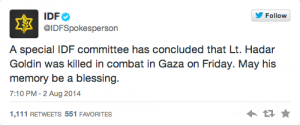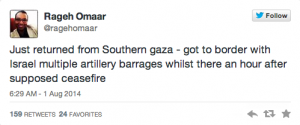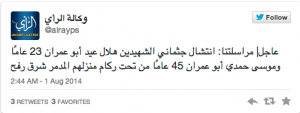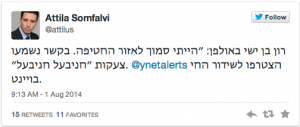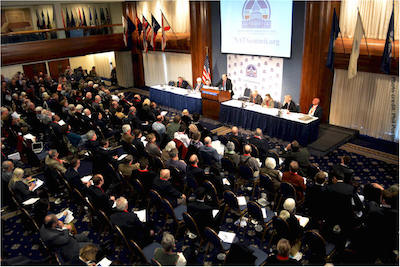Did Israeli army deliberately kill its own captured soldier and destroy Gaza ceasefire?
Aug 2 2014 / 2:01 am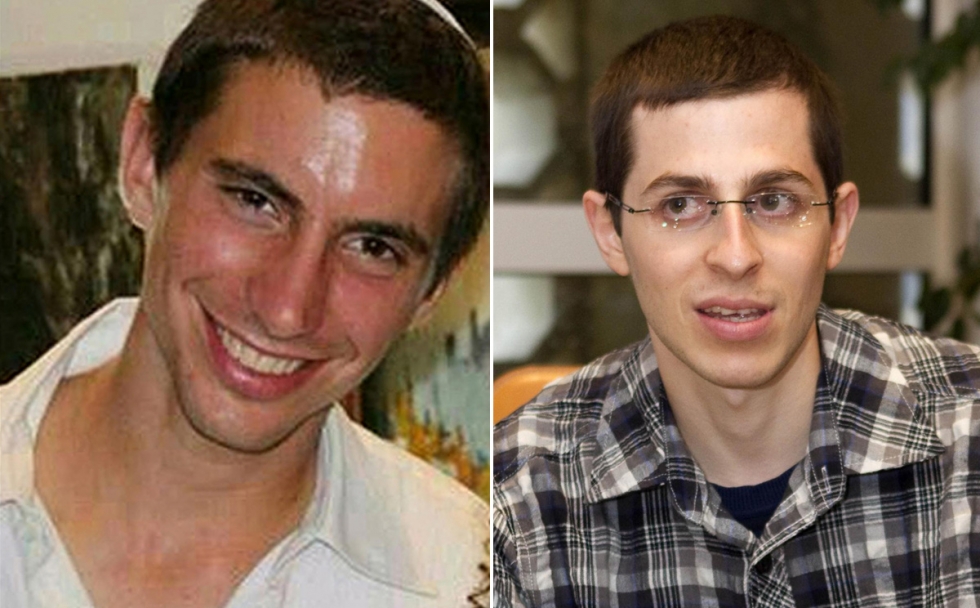
By Ali Abunimah.
The Electronic Intifada – Update, 2 August: Israel acknowledges soldier is dead
On Saturday evening, the Israeli army stated that Hadar Goldin, the soldier it claimed Hamas had captured on Friday morning, is dead:
It was on the pretext of searching for the missing soldier that Israel slaughtered at least 110 of people in the southern Gaza town of Rafah since Friday morning, destroying what was supposed to be a 72-hour humanitarian ceasefire. But the toll is rising as more bodies are found.
“Such was the savagery of Israel’s bombardment in Rafah, such was the quantity of dead bodies, that there was simply no other option but to use vegetable refrigerators as makeshift morgues,” journalist Mohammed Omer, who hails from Rafah, reports.
In one such freezer, Omer saw “the corpses of children, young men and women lying on top of one another, soaked in blood. Many were impossible to identify and only a few have been placed in white burial shrouds.”
One wonders whether US President Barack Obama will now retract his hasty statement – no doubt based on misinformation from Israel – blaming Hamas for capturing the soldier and demanding that he be “unconditionally” released.
Now that Israel has, like Hamas, concluded that Goldin is dead, the question remains whether someone in the Israeli army gave the order to shell Rafah to kill him and prevent Hamas taking a live prisoner. Read on…
Original post
Friday turned into yet another day of horror for Palestinians in Gaza, as Israel committed massacres and atrocities claiming the lives of at least 100 people.
It wasn’t supposed to be that way. Friday was meant to be the first day of a three-day “humanitarian ceasefire” announced on Thursday evening by the United Nations and the United States.
The short-lived ceasefire was scheduled to begin at 8am local time on Friday morning.
Predictably, the United States has blamed Hamas for violating the ceasefire by killing two Israeli soldiers and capturing a third, whom Israel named as Hadar Goldin.
Hamas and its military wing the Qassam Brigades deny any knowledge of the missing soldier.
Who really broke the ceasefire? And why did Israeli forces shell the southern Gaza Strip city of Rafah so indiscriminately on Friday, slaughtering dozens of people?
Could it have been in order to kill the captured soldier to prevent him becoming a valuable bargaining chip in the hands of the Palestinian resistance?
Israel has long had a murky procedure called the Hannibal Directive that some interpret as an order to do whatever it takes to prevent a soldier’s capture, even if it means killing him in the process.
What happened? Israel’s version
Here’s Israel’s version, as reported in Ynet:
According to an announcement by the IDF [Israeli army], at 9:30 am Friday, terrorists opened fire at IDF forces in southern Gaza. Initial information from the scene indicated that there is a chance that an IDF soldiers [sic] was kidnapped [sic] during the incident.
Israel claims that the soldiers were working to destroy a resistance tunnel and that such “defensive” activities were permitted by the ceasefire agreement.
What Israel does not dispute is that its occupation forces were carrying out operations in the Gaza Strip.
What happened? Hamas’ version
Hamas strongly disputes the Israeli timeline, and accuses Israel of violating the ceasefire.
In a military communiqué published on its website on Friday, Qassam stated:
After its blatant aggression and violation of the ceasefire, the enemy [Israel] began to spread the lie that the resistance violated the truce. We confirm that over the past twenty days no Zionist soldier had any presence in the eastern area of Rafah. After the announcement that a ceasefire agreement had been reached, the enemy began to move in that area and at precisely 2am made an incursion 2.5 kms east of Rafah. This leaves no room for doubt about the enemy’s intention to violate the truce and infringe on our territory and our defenseless people. Faced with this Zionist advance, at precisely 7am our fighters engaged with the invading forces and caused a large number of deaths and injuries in their ranks.
In a statement early on Saturday morning, Qassam explained how it had understood the ceasefire:
We notified the mediators that took part in arranging the humanitarian ceasefire that we agree to a ceasefire with regard to the sites that we target in Zionist cities and towns, but from an operational standpoint we cannot cease firing toward forces that have entered the [Gaza] Strip and are operating and moving constantly. This means that it is possible for any invading force to encounter one of our units and this could lead to clashes.
From Qassam’s perspective, a clash between armed combatants should not have led to a total breakdown of the humanitarian ceasefire.
So according to Qassam, the operation against the Israeli soldiers was defensive in nature and occurred an hour before the 8:00 am start of the ceasefire.
Time difference
There is a two and a half hour gap between Israel’s version and Hamas’ version which cannot be resolved with the information currently available.
But a more important question, especially if we take Israel’s account at face value, is when and why Israel started its intense shelling east of Rafah.
Rageh Omaar, the long-time BBC correspondent who is now in Gaza as the international affairs editor for the UK’s ITV News, actually traveled to southern Gaza on Friday and filed a report on the horrifying aftermath of earlier Israeli massacres in and around Khan Younis.
But an interesting observation comes from this tweet:
If Omaar is right, this would mean that Israel was already heavily shelling in the Rafah area by around 9am, since the ceasefire was supposed to begin at 8am.
And if the artillery barrages followed the killing and alleged capture of Israeli soldiers by Qassam it would also mean that the incident could have occurred before 9:30am.
At 06:44 UTC, 9:44 am Gaza time, local news agency Alray tweeted in Arabic:
“Breaking | Our correspondent: Recovery of the two bodies of Hilal Eid Abu Imran, age 23, and Moussa Hamdi Abu Imran from under the rubble of their destroyed house east of Rafah.”
Both men were later named by medical officials as among around 60 people killed in Israel’s artillery barrage.
Given that this tweet was made at 9:44am, the shelling itself must have occurred earlier, with enough time for medics to reach the shelled house, to remove and identify the bodies and for their names to be reported.
Around 10am many more reports started to come in of mass casualties from “indiscriminate shelling” on George Street, east of Rafah.
If the shelling indeed began between 9 and 10am, it would mean that Israel launched a massive and indiscriminate barrage at just about the time it says its soldier was captured.
This makes no sense if Israeli forces wanted to ensure the captured soldier’s safety. After all, he could be killed along with his captors.
And that is exactly what Qassam thinks happened.
What about the soldier?
Qassam did not comment for the whole of Friday on Israel’s assertion that one of its soldiers was captured.
Early on Saturday it issued a new military communiqué condemning the “ongoing horrifying massacre of civilians in Rafah” and reaffirming its earlier version and timeline of events.
But it has these important additions:
We lost contact with the group of fighters that were stationed at that location and we believe that all members of the unit were martyred and the soldier the enemy says went missing was killed in the Zionist shelling, assuming that the fighters did capture him during the confrontation.
We in Qassam have no knowledge up to this moment about the missing soldier, nor his whereabouts nor the circumstances of his disappearance.
It is reasonable to assume that Qassam has no motive to be deceptive about this; a captured Israeli soldier is a valuable asset. If they had him they would either boast about it or keep quiet and perhaps seek to trade information about him for concessions from Israel.
Did Israel do it deliberately?
If the Israeli soldier was killed, it is possible that it was unintentional “friendly fire.”
But again, forces that were intent on protecting and rescuing a missing soldier would be foolhardy to launch massive air raids or barrages of artillery fire in the area where he was captured.
This leaves open the question of whether Israeli forces intended to kill the missing soldier.
The Hannibal Directive
The “Hannibal Directive” captured the Israeli imagination in the mid-1980s, when ongoing incursions and occupation in Lebanon, following the 1982 invasion, confronted the Israeli army with opportunities to experience capture.
Popular understanding of this directive is phrased as “a dead soldier is better than a kidnapped [sic] one” – which was taken to mean that it would be better to kill a captured prisoner of war than have him remain alive.
The political cost to Israeli leaders from a live captured soldier could be seen during the five years Gilad Shalit’s family campaigned for Israel to secure his release and the high price many Israelis felt had to be paid: an exchange for more than one thousand Palestinian prisoners.
Evolving from an order never committed to paper, the directive is ascribed to military leaders Yossi Peled, Gabi Ashkenazi and Yaakov Amidror in 1986.
Military censorship strove to keep it hidden, and chief military ethicist Asa Kasher acted to phrase it in writing, so as to avoid its blatant illegality.
Kasher attempted this clarification again this week, saying:
The order has parallel phrasings, for some reason, but the principle shared by them all, as expressed in one of those: ‘action must be taken, inasmuch as possible, to halt the kidnapping [sic] operation, including deploying live fire, but not in a way that could lead with high likelihood to the death of the kidnapped [sic] person, through the understanding that the value of the kidnapped [sic] person is higher than that of the kidnapping [sic].
Recurring denials such as Kasher’s combine with extensive discussion of the directivefrom a rabbinical point of view, and reports in the popular press, including following “Operation Cast Lead,” Israel’s 2008-2009 Gaza invasion, about the bombing of a Gaza home where the body of a soldier was being held.
It is clear that the spirit of the directive lives on, even if there are orders in writing that prohibit it.
“Hannibal! Hannibal!”
There was much discussion on Twitter about this being the reason for the shelling of Rafah on Friday morning, including in reports from Ynet’s military reporter Attila Somfalvi, that the words “Hannibal! Hannibal!” were shouted over military communication systems.
Journalist Haim Har-Zahav reminisced that it took 50 minutes before the directive was put into practice on the Lebanon border, in 2006 and almost an hour in 1991, but that his own brigade took only a few minutes.
Sports commentator Ouriel Daskal stated outright: “what I deduce from what’s happening in Rafah is that there’s an implementation of the Hannibal Directive. Let’s hope not.”
Moreover, blogger Richard Silverstein reported a few days ago that another soldier was killed in Gaza under the directive.
Israeli investigative journalist Ronen Bergman confirmed in a radio interview, with respect to an earlier incident, that in Gaza the procedure “was tested in practice and apparently the soldiers acted in accordance with that directive.”
Israel has also declared Oron Shaul, a missing soldier whom Qassam does say it captured, to be dead.
Obviously, Israel is not going to come clean about such a practice.
But these indications, combined with the fact that Israel bombed Rafah so viciously make it a reasonable hypothesis that someone giving orders on Friday morning wanted the soldier dead rather than captured.
If that is the case, then it is Israel that destroyed the humanitarian ceasefire, in the process murdering dozens more innocent people and pushing the death toll from the ongoing massacre in Gaza to more than 1,600 people.
—–
With thanks to Dena Shunra for extensive research and Hebrew translation related to the Hannibal Directive.

